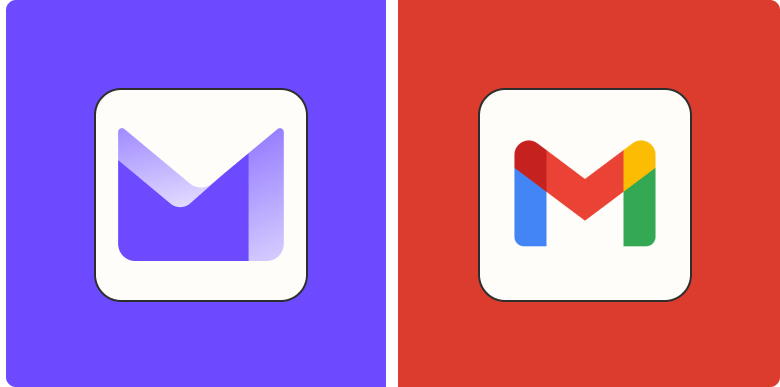Email is an internet dinosaur. But despite its age, it’s still how most people communicate at work, how marketers reach you, and how a lot of sensitive information is exchanged. And there are more email services and apps than ever to choose from.
There’s a better way to deal with email.
Here, we’ll take a look at Gmail vs. ProtonMail. I’ve been using Gmail for 14 years, and I’ve used multiple ProtonMail accounts over the past two years—not for shady stuff, I promise. I dug deep into each one to take a deeper look and see how they stack up.
Whether you’re shopping around for an extra email account or fully transitioning from your old one, read on to find what each of these services has to offer.
ProtonMail vs. Gmail at a glance
ProtonMail (sometimes written Proton Mail) is the underdog with better privacy and more security features, facing a billions-of-users-strong Gmail with a better user experience and more integrations.
|
ProtonMail |
Gmail |
|
|---|---|---|
|
Pricing |
⭐⭐⭐ Free plan available; subscriptions start at $5/month |
⭐⭐⭐⭐⭐ Generous free plan; subscriptions available via Google One or Google Workspace |
|
Ease of use |
⭐⭐⭐⭐ Intuitive, but security features come with a learning curve |
⭐⭐⭐⭐⭐ Easy and intuitive |
|
Security |
⭐⭐⭐⭐⭐ Self-destructing and password-protected emails; end-to-end encryption (PGP) |
⭐⭐⭐⭐ Industry standards: TLS for client/server communications; 128-bit AES encryption for inbox contents at rest |
|
Privacy |
⭐⭐⭐⭐⭐ Zero-knowledge; no IP logging; under Swiss jurisdiction for legal purposes |
⭐⭐ User metadata is used for analytics, extra services, and monetization |
|
Integrations |
⭐ No integration with other apps, except for Proton Drive |
⭐⭐⭐⭐⭐ Integrates deeply with the Google software suite and with thousands of other apps via Zapier |
|
Email client integration |
⭐⭐⭐ Paid plan required to access ProtonMail accounts from other email clients (e.g., Outlook, Thunderbird, Apple Mail, etc.) |
⭐⭐⭐⭐⭐ Gmail accounts can be opened on almost any email client; Gmail mobile app opens email accounts from other providers |
ProtonMail has superior privacy standards
Switzerland is more than precise clockwork, holey cheese, and neutrality. It has tight data protection laws too. ProtonMail is based in Switzerland, which makes it bound to:
-
The Swiss constitution’s Article 13 (general guidance on privacy rights)
-
The Swiss Data Privacy Act (unique protection for Swiss citizens and for data handled by Swiss companies)
-
The European Union’s GDPR laws (even though it’s not a member state)
Buried deep within the mountains, 1,000 meters underground, a nuclear-strike-proof bunker houses ProtonMail’s data center. A cool story for cocktail parties, but what’s more important is that it falls outside the jurisdiction of both the US and the UK. If any government wants to peek at user information, they’ll have to face Swiss courts first, and they’re pretty strict regarding personal data.
ProtonMail is ok with not having information about you. When you create an account, simply type in the account name and password, and you’re set. You don’t have to add any other personal information if you don’t want to, and the service doesn’t record your IP. Want to pay for a ProtonMail subscription with Bitcoin? You can. Zero-knowledge at its best.
Google does things differently. No, it doesn’t have data centers in locations that James Bond villains would approve of, but it has an impressive track record of both physical and digital safety. As for the way it treats its users’ data, well, it’s complicated.
On top of asking for a lot of personal information upfront during signup, Google tracks your IP and processes the data you own and metadata you generate through internal algorithms. All this data is used to support other Google products and services, such as showing shopping ads in your inbox and enabling the Smart Compose and Smart Reply features.
Google also falls under US jurisdiction, so if you’re not comfortable with how the American government requests and handles personal information, this could be a major turn-off.
ProtonMail wins the privacy game by a large margin. There’s a caveat, though. A French climate activist was arrested after Swiss courts ordered ProtonMail to track their IP. If you’re a whistleblower, activist, or journalist, you’re probably already using more advanced tools, but keep in mind that, while ProtonMail can withstand nuclear strikes, it can’t resist all court mandates.
Gmail has a better free plan
Gmail’s free plan is wonderful. The best, hands down. 15GB of free storage for all your emails, on polished mobile and web apps, with access to the entire Google software suite. If you manage your Google storage well, you can use it for decades without ever having to pay. What’s not to like?

If you need raw storage, a Google One subscription can bump your account to 100GB for $1.99 per month. If you want other features, such as custom email domains, you can upgrade to a Google Workspace subscription and empower the entire software suite starting at $6 per month.
How can Google be so generous with its free plan? Well, the company is huge, it has multiple revenue streams, and we’re not exactly sure how much our personal data plays into the bottom line (but it’s easy to suspect it’s one of the major factors).
On the other hand, ProtonMail is a smaller, newer company, and it isn’t in the data collection/analytics business. When you purchase a subscription at ProtonMail, you’re getting the extra features and also supporting their privacy-first approach. These reasons may explain why the free plan looks so modest in comparison, though:
-
You can only send 150 emails per day
-
There’s only 500MB of storage (upgraded to 1GB if you complete all the onboarding steps, shared with Proton Drive)
-
Organization is limited to 3 folders and 3 labels
-
Additional addresses and custom email domains aren’t supported
This should be ok for casual users, but if you want to move everything over to ProtonMail, it won’t last long. Notable features of the $5 per month Plus plan include:
-
Up to 10 email addresses and support for one custom domain
-
15GB of storage
-
Access to the short domain @pm.me to send and receive email
-
Unlimited organization (folders and labels)
-
Ability to open your ProtonMail account on a different email client (e.g., Outlook or Apple Mail)
ProtonMail has more security options
First, it’s important to note that both Gmail and ProtonMail provide great protection against people trying to get inside your email account. Most of it happens at the infrastructure level and also through features like multi-factor authentication.
But ProtonMail has an edge because it operates on a zero-knowledge, end-to-end encryption principle. This means that no one, not even the people at ProtonMail, can read your email exchanges with anyone. To fully explain what this means, let’s get a bit technical.
ProtonMail uses PGP (Pretty Good Privacy) as a standard for communications. It contains a set of cryptography techniques and processes that ensure only the sender and the receiver of the emails have access to it. No one else can read or change the contents of an email, and encryption keys to reveal them are never in the hands of anyone else.

In contrast, Gmail uses standard TLS (Transport Layer Security), which secures messages sent between users and Google servers. This is different from PGP because it lets Google keep the encryption keys that reveal your data. As for the emails already in your inbox, they’re protected by industry-standard 128-bit AES (Advanced Encryption Standard). Google’s standards are excellent, but the fact that it holds your encryption keys means that your data is visible to Google algorithms and whoever Google provides access to (e.g., court mandates).
However, both ProtonMail’s PGP and Gmail’s TLS + 128-bit AES can’t fully protect you from an account breach. If someone hacks your device and gains access to your email, they’ll be able to read everything just as you do. Here, ProtonMail has a couple of options that help keep your inbox protected if this ever happens, but you’ll have to actively use them and understand how they work.
The first extra feature is the possibility to send password-protected emails. Before sending the email, you set a unique password. When the receiver gets your email, they have to click a link to open that message and input the password to read it. Even if a hacker gains control of any of the two accounts, they won’t be able to read that email unless they find the password.
The other security option is self-destructing emails. When you send an email, you set an expiration date. And, as if it were Snapchat, once that date passes, the email disappears. By using both these features, you can send and receive sensitive information with peace of mind. Even if the worst happens, you know that your data will be safe.
One last detail: to fully take advantage of all the privacy and security features with ProtonMail with minimum setup, both you and the receiver must use a ProtonMail account. If your correspondents insist on sticking with another email provider, you have to set up the encryption yourself, which is doable but a bit tricky.
Gmail is easier to use
It’s no Apple, but Google focuses a lot on ease of use. The investment in this area is so deep that Google even shares its user experience principles—check out Material design‘s website if you’re curious.
Both the web app and the mobile app are intuitive, fast, and easy to use. When you log in on a computer, all your labels sit on the left side, with plenty of space in the middle and right side of the screen for all your emails organized in conversation threads. At the top of the list, you’ll always find the toolbar to carry out all the actions you need to keep emails organized.

Gmail also sorts your emails into categories with a set of pre-made filters. For example, Google figures out which emails are promotional and puts them all in a separate Promotions tab. The same goes for emails from social networks, so you can keep things separate from your main inbox.
The Gmail mobile app also acts as an email client. If you have accounts with other providers or from a custom domain, you can still open and interact with them in your Gmail app (though it doesn’t do so as elegantly as, say, Apple Mail).
ProtonMail has come a long way, but it’s still a bit behind Google here. The web app is easy to use, but leveraging all the security features takes some getting used to. There’s a slight lag when opening emails and refreshing your inbox. It also blocks images on the emails you receive—to stop them from tracking your open rates, for instance—so you’ll have to click to display images to keep the email layout looking good.

The mobile app is in line with the web experience, with one major difference: you can set it to open with touch ID or a PIN, so you can make sure it’s really you using it at all times.
Gmail integrates with Google’s software suite
Gmail isn’t the only thing that’s free with your Google account. There’s the entire Google software suite waiting for you, including Google Docs, Google Sheets, Google Calendar, Google Slides, Google Forms—the list goes on. You can access some of their functionality directly from the Gmail app, sometimes even from the body of an email—like responding to a Google Calendar invitation. You can even do things like send Gmails directly from Google Docs.
And you’re not just limited to Google Workspace apps. You can connect Gmail to Zapier, which means it integrates with thousands of other apps. Here are some examples of what you can do:
ProtonMail does have some other products to offer you:
-
Proton Drive for file storage and sharing
-
Proton VPN for secure and anonymous browsing on the web
-
Proton Calendar for scheduling your daily to-dos
On the paid plan, you also get access to Proton Bridge, a desktop application that encrypts and decrypts all your mail, all while running in the background.
But other than that, ProtonMail doesn’t have any other integrations.
Regarding integration with email clients like Outlook, Thunderbird, or Apple Mail, Gmail lets you link your account to any of these clients and manage your mail from there, even on the free plan. And as I mentioned above, you can use the Gmail mobile app as an email client as well: add email accounts from other providers and keep everything in one place.
ProtonMail isn’t as generous here. You have to upgrade to a paid plan to open your ProtonMail account in other email clients, and you can’t add accounts from other providers to any of the ProtonMail apps.
ProtonMail vs. Gmail: Which should you use?
You should go with ProtonMail if:
-
You’re worried about the safety and privacy of your online communications
-
You’re sending and receiving a lot of sensitive data
-
You’re not looking for productivity or integration features
You should go with Gmail if:
-
You value ease of use and flexibility
-
You’re using or planning to use other Google Workspace apps
-
You’re looking for a free email service with a generous feature set
Or, what about both?
It’s not an either/or situation. You can use Gmail for regular day-to-day personal emails and ProtonMail for more sensitive communications. Some people even consider ProtonMail as a “burner account” provider, so you can access some online services without giving out your private data if you don’t trust them.
Related reading:
[adsanity_group align=’alignnone’ num_ads=1 num_columns=1 group_ids=’15192′]
Need Any Technology Assistance? Call Pursho @ 0731-6725516




